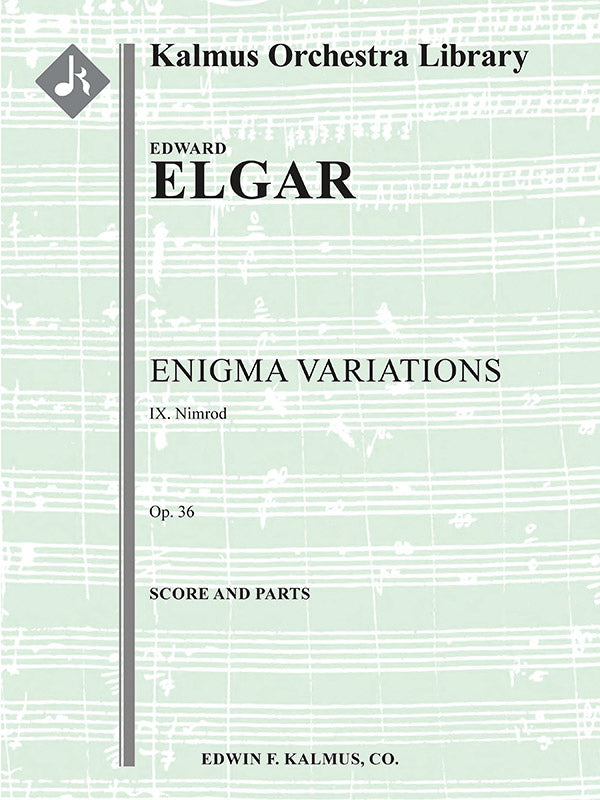Elgar: Nimrod from Variations on an Original Theme, Op. 36, No. 9
In stock and typically ships within 1 business day.
- Composer: Edward Elgar (1857-1934)
- Instrumentation: Orchestra
- Work: Variations on an Original Theme ("Enigma Variations"), Op. 36
- UPC:
- Size: 9.0 x 12.0 inches
Description
In October of 1898, Edward Elgar returned home after a long day of teaching, ate dinner, then sat down at the piano to doodle on the keys. Elgar described what followed: "In a little while, soothed and feeling rested, I began to play, and suddenly my wife interrupted by saying: ‘Edward, that's a good tune.' I awoke from the dream. ‘Eh! Tune, what tune!' and she said, ‘Play it again, I like that tune.' I played and strummed, and played, then she exclaimed: ‘That's the tune.' The voice of [my wife] asked with a sound of approval, ‘What is that?' I answered, ‘Nothing – but something might be made of it.'"
This tune is what became the theme to one of the greatest works in the orchestral repertoire, VARIATIONS ON AN ORIGINAL THEME or the ENIGMA VARIATIONS. Elgar called the variations "Enigma," not to be thought of as a riddle so much as a "dark saying [that] must be left unguessed.," though he also hinted that a hidden melody is also embedded within the music. Each of the fourteen variations functions as a musical caricature of a specific friend, starting with his wife Alice ("C.A.E."), and ending with himself ("E.D.U.").
Variation No. 9, "Nimrod" is a caricature of Augustus J. Jaeger. The work premiered in 1899 at St. James Hall in London, conducted by Hans Richter, and acheived immediate popularity, establishing Elgar's international reputation.
Istrumentation: 2.2.2.2+CBsn: 4.3.3.1: Timp: Str (9-8-7-6-5 in set).
Publishers use a lot of words to describe what they sell, and we know it can be confusing. We've tried to be as clear as possible to make sure you get exactly what you are looking for. Below are descriptions of the terms that we use to describe the various formats that music often comes in.
Choral Score
A score for vocalists that only contains the vocal lines. The instrumental parts are not there for reference. Generally, cheaper than a vocal score and requires multiple copies for purchase.
Facsimile
Reproductions of the original hand-written scores from the composer.
Full Score
For ensemble music, this indicates that the edition contains all parts on a single system (there are not separate parts for each player). In larger ensembles, this is for the conductor.
Hardcover
Hardbound. Generally either linen-covered or half-leather.
Orchestral Parts
Similar to a wind set, this is a collection of parts. In the case of strings, the numbers listed are the number of copies included, though generally these are available individually (often with minimum quantities required).
Paperback
When publishers offer multiple bindings (e.g. hardcover) or study scores, this is the "standard" version. If you're planning to play the music, this is probably what you want.
Performance / Playing Score
A score of the music containing all parts on one system, intended for players to share. There are not separate parts for each player.
Set of Parts
For ensemble music, this indicates that there are separate individual parts for each player.
Solo Part with Piano Reduction
For solo pieces with orchestra, this is a version that contains a piano reduction of the orchestra parts. For piano pieces, two copies are typically needed for performance.
Study Score
A small (think choral size) copy of the complete score meant for studying, and not playing. They make great add-ons when learning concertos and small chamber works.
Vocal Score
A score prepared for vocalists that includes the piano/organ part or a reduction of the instrumental parts.
Wind Set
For orchestral music, this is a collection of wind and percussion parts. The specific quantities of each instrument are notated.
With Audio
In addition to the printed music, the edition contains recordings of the pieces. This may be an included CD, or access to files on the internet.
With / Without Fingering (Markings)
Some publishers prepare two copies - a pure Urtext edition that includes no fingering (or bowing) suggestions and a lightly edited version that includes a minimal number of editorial markings.



